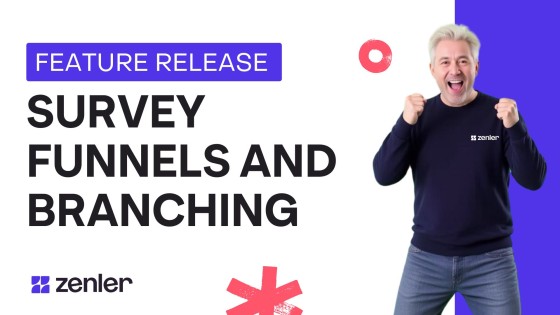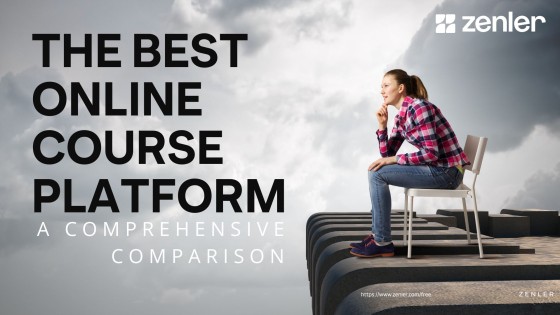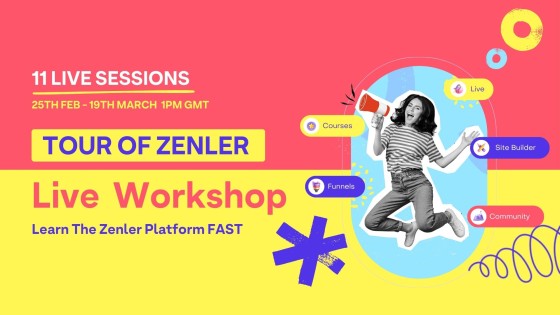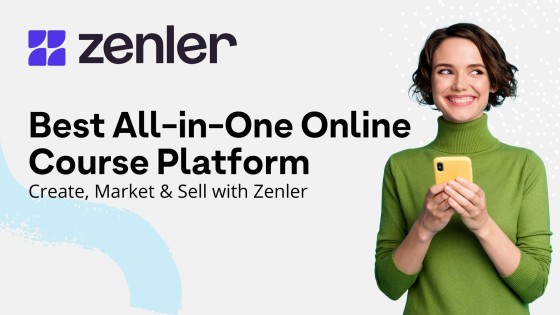Learn How to Sell Courses Online with These Tips Through the Right Online Course Platform!
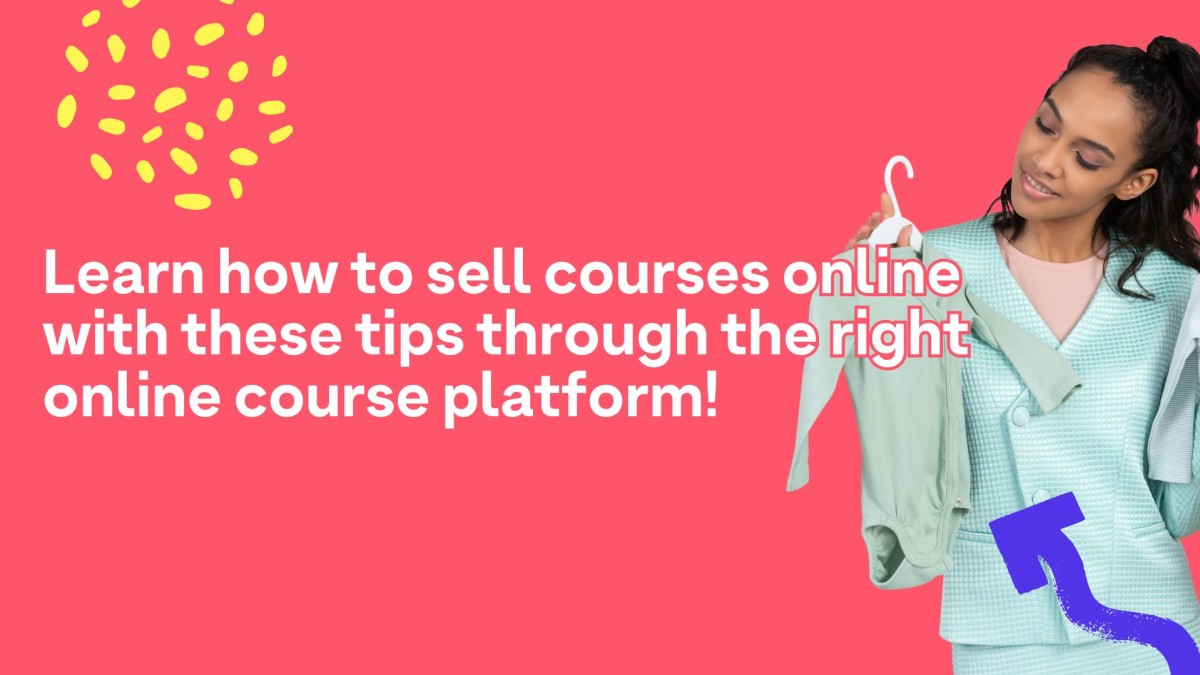
There has been a significant shift in the e-learning space in the last decade.
This is due to a congruence of many market aspects like demand, competition, technological advancements, and most notably, the pandemic. Technology rose to meet the challenge the pandemic created for educational institutions. What started as a way to tide things over until we reached the “new normal” again became one of the biggest learning revolutions we have ever seen. The rise of online learning by traditional learning institutions also spilled over to every other aspect of e-learning. Online courses started gaining more traction and popularity.
Studies showed that online learning was set to grow by 200% between 2020 and 2025. These were predictions before the pandemic accelerated and facilitated our dependence on it, fuelling it further. All this to say, online course platforms are an exciting space with immense growth potential for online course sellers and buyers. If the stats piqued your curiosity, here are some qualitative reasons why online courses are more popular now than ever to further cement our pitch.
What Makes Online Courses So Popular?

Online courses are a great way for people who want to quickly upskill and learn something new in their industry.
Accessibility: Students can learn from anywhere and at any time through online course platforms. It removes all geographical barriers, making education more inclusive and flexible. On the other hand, online course creators and educators gain access to an established platform through which they can sell their courses.
Affordability: Students prefer lessons that are light on the pocket while being informative. Educators get a platform for an affordable platform access fee, which is more of an investment for long-term returns. Both parties benefit!
User-Friendly: Both at the front end and the back end, online course platforms make it easy for people to engage with course materials, with a simple layout and a beginner-friendly design.
Need to Upskill: This is one of the main reasons that make online course platforms so popular among students. The job world is constantly evolving, needing a constantly updated resume. Short-term and informative online courses are the go-to ways to get certified and gain more niche expertise in any field.
Students constantly look for accessible and affordable upskilling opportunities in online learning platforms. This is where you come in to bridge the gap. If you know how to package and sell your course, you can be a part of an industry that is set to grow at a CAGR of 14% from 2023-2032.
How To Sell Courses Online: Is It Profitable?

An online course platform is a neat way to package your expertise into clearly accessible portions for consumption. Its user-friendliness and lack of geographical barriers, combined with the high investment in the e-learning space make it a lucrative space for you in 2024.
High Demand: The job market is dynamic and ever-expanding, making online course platforms a great springboard for upskilling, especially in digital marketing, tech, and analytics. The high demand is also because of supply: The more attractive your course is, the faster it captures the audience. So, its success and profitability directly relate to its packaging.
Global Reach: The potential for your online course is limitless. The global reach that your course gets at the click of a button enhances your Return on Investment significantly. In a nutshell, a diverse audience creates a cascading effect and boosts the demand for your content. Using an online course platform like Zenler gives you and other content creators access to many students who are interested in your content.
Low Set-Up Costs: Online courses ensure nominal set-up costs. Your investments include the right recording equipment and a fee to your partner platform. In return, you gain access to a diverse audience base and the opportunity to make a regular stream of income. The earning potential in comparison is exponential. This is one of the main reasons why content creators learn how to sell courses online.
Long-Term Profitability: Online course platforms give you a sustained income. This is, in part, due to their scalability: You can add more lessons to your course, input more interactive segments, and create different segues that scale up your course and its demand. The opportunity to learn more is always great because it increases enrollment without additional costs. Moreover, your part in the course is mostly done when you upload it on our platform. The revenue, however, is continuous. A student can access your digital marketing course from 2020 and you will still get paid for it.
How to Sell Courses Online: An 11-Step Guide

If you are an educator, an entrepreneur, or just an expert with lots of knowledge, then online courses are the next big career step. You are knowledgeable, but remember, that is just the first step in the right direction. You need an overarching plan with answers to the what, when, where, how, and why.
In this guide, we will walk you through 11 steps you need to create and know how to sell your online courses. The goal? Maximizing your reach and revenue potential.
Step 1: Choose Your Niche
This is where the answer to “how to sell courses online” begins: Picking the right subject matter. While this might sound simple, it is crucial to sell your expertise the right way. Pick a subject you know. Obvious? Maybe. Important? Very.
How do you do that? Learners click on your course, then trust and invest in your knowledge if you have the right qualifications. Whether this is a master’s degree, a professional certification course, or extensive work experience in your field, expertise backed up by quantitative proof sells. You become a credible source for the high-quality content the audience wants.
With the subject matter down, move on to the market. Choose a niche that corresponds to what the market currently demands or shape your niche to respond to market gaps to sell your online course. Research what students are looking for and what skills are in high demand in the job industry.
For example, if you have expertise in database management and a certification in social media, pick a niche like data analytics in marketing. By picking something that aligns with both your strengths and market needs, you are better set to add value to the online course platform and cut through the clutter. This foundation ensures long-term profit potential.
Step 2: The Pre-Production Phase
The pre-production phase is when you plan how to sell courses online. This is the stage that sets you up for a smooth process up until you publish the course. It is especially crucial because you are a subject matter expert and you want to showcase your expertise well.
Ensure the two “E”s of pre-production: Equipment and Environment. First, to deliver a high-quality audio-visual experience, invest in a good camera and a high-quality clip-on microphone. The camera can be a professional one, but with advancing technology, you can shoot it on any of the latest smartphone models with the highest quality. Apart from that, you also need a tripod for stable footage.
Second, consider the shooting space. Your needs might differ depending on what you teach. For example, if it is mathematical equations, having a well-organized study space with a whiteboard is helpful. If you want to create an online course on social media posting strategies, a virtual background might be better. Ensure a well-lit space with natural light or a ring light for optimum clarity. Make a checklist for each phase to stay updated with all tasks.
Step 3: Content Structuring
Before the scripting process, lay the groundwork for your online course platform. A content structure is like a curriculum plan for any classroom, you plan out the lessons from start to finish before you plan out what to say. This is done for:
Clarity, not just for your potential students but also for yourself
Logic and flow of content
Content organization
In essence, you want your students to be able to follow a storyline, from beginning to end when you think about how to sell your courses online. This means leading each section into the next one. A roadmap makes it easier for you to plan what you want to say specifically.
Another important part is to understand how much time to allocate for each section. Plan the main topics and break them down into smaller subtopics. For example, if you are working on a digital marketing analytics course, the content structure could look something like this:
Introduction to digital marketing -> Social media platforms and strategies -> Insights and data -> SEO basics -> Other marketing strategies (Email marketing, sms marketing)
Each module effectively flows into the next, and by the end of it, the learner has a comprehensive idea of every part of digital marketing.
Step 4: Scripting
Once the content structure is set, your next step is to script your online course for the platform. Use the roadmap to make your writing process more manageable. Break the structure down into individual videos and keep them short. If your course is more extensive, sometimes even longer duration videos work well with the audience. Understand your target group before deciding on the duration.
Use clear, simple, and cohesive sentences to explain your topic, so that however complex the subject is, it is understandable. Use selective jargon and explain it too, so you give an in-depth understanding of the subject matter. Then, create a story arc, with a beginning, middle, and end.
For example, if your module is “Introduction to Social Media”, the beginning speaks about what social media means, a brief history of how it began and where it is now, and the different platforms. The middle goes into what kind of content you can post in brief, and the end leads to the next segment about how to create content for social media. Incorporating transitions in your script maintains the learners’ curiosity and drives them to the next lesson.
Pro tip: Have more than just blocks of content modules in your “how to sell courses online” checklist. Allocate time for tests, Q&As, and other activities so your students can revise what they learned in each section. Keep an organized lesson structure so it is easier to stay focused and have a great value-add to their resume.
Step 5: Get Ready to Shoot!
Now, you are all set to move from Phase 1, pre-production, to Phase 2, production. When you shoot the videos for your online course, plan carefully and focus on the details. The idea is to create an output that is both engaging and professional. Here are the tips to keep in mind:
Choose a space with lots of natural light. The natural light needs to be on your face, so place the camera in the direction of the light.
Do a test shot to see how your classroom setup looks in the light. If natural light is not enough, place your ring light behind the camera. This is called the “fill light” and it helps minimize shadows disrupting your lesson videos.
Set up the camera at eye level. Make sure it is set to high resolution and auto-focus so that both the foreground (you) and the background (whiteboard, props) are in focus. A wide 16:9 frame works.
Do an audio test before shooting. Clip your mic on your shirt and make sure it picks up only your voice and no cloth rustling or other background noise. Choose a quiet place to shoot.
Speak clearly, maintain eye contact, and use body language to engage your audience. Use your script as a reference instead of reading out exactly what is on it.
Do not hesitate to reshoot sections if you aren’t convinced. Multiple takes are helpful when putting together the final product.
Step 6: Editing and Packaging
The next step in the how to sell courses online process? Edit it into sections or episodes and prepare for the final product- your online course. This phase is the only step you have before you prepare to sell and market your course on the online course platform. Here’s what you should know:
Organize all the recorded footage into the chronology you prefer for the final course. Review each segment and choose the best take for each of them. Put it into a final folder so that you know exactly which ones to use without wading through the files.
You can use professional video editing tools like Adobe Premier Pro, but simple video editing tools like InShot, Canva, Filmore, or Capcut also work well. The editing software has information on snipping videos, interspersing them, adding effects and transitions, and rendering a final output. Outsource this part if you want a professional’s help, but it is possible to do it yourself.
Trim the awkward pauses, cut the fillers, and anything that does not work well for the final lesson. Insert the required graphics, images, and screen recordings. For example, a bar graph is helpful when the segment is about the number of social media users by demographic.
Edit out the background noise and adjust volume levels so your voice is heard clearly without any interruptions. Wherever necessary, add background music, though we advise you to keep it minimal.
Video editing software comes with audio transcription, making subtitling accessible and efficient. Subtitles open up your lessons to a wider demographic, so even if they don’t speak your language or have a hearing disability, they can still access your course.
Once you check all these boxes, hit render on your final video. Follow that for all your lessons until you have a final package with the planned number of lessons. Add intros and outros to create a cohesive final product, with digestible modules and lessons. By focusing on editing and packaging, you’ll deliver a professional and engaging online course for the platform that resonates with your audience.
Step 7: Choose Your Online Course Platform
Your product is edited, packaged, and ready to go. What now? This is a critical step for a successful online educator. Several online course platforms offer various online courses. Which one works best for you? Here’s how you find out.
Choose an online course platform that has an established reach. Bigger platforms are widely known among people who want to upskill, so your visibility is boosted. This saves time and money.
Choose a platform that provides easy access to marketing and SEO tools. These in-built tools make it easy for in-app promotions and pay once and for all to the platform, instead of spending extra on promotions.
Choose an online course platform with a friendly user interface, from uploading to payment processing. Your comfort matters when you put your online course out into the world so that you can ensure a seamless experience for your students.
Moreover, choose an online course platform known for its customer support and security. Read reviews on the website or on other sites like Reddit and Quora to gauge what the platform’s services are like.
Choose the online course platform based on what features you need. Purely video courses do well on some platforms while others focus on interactive elements.
Compare platform fees or revenue splits. The Return on Investment needs to be viable before you choose the online course platform.
Decide how much control you want on your online course. Platforms range from full-range customization to preset guidelines. If you are new, choose an online course platform that aids your product packaging.
Step 8: Monetizing Your Online Course
Your online course is a major revenue source. A comprehensive pricing plan is crucial for turning your online course profitable. The right strategy will elevate your valuable and well-packaged content to the next level. Here’s how you monetize your online course on your platform:
Research the market demand and set a competitive price based on the value, topical trends, and duration.
Split your course into different tiers such as basic, premium, or certification to appeal to various audiences.
Come up with a subscription model to encourage long-term revenue generation.
Offer legitimate certifications that meet industry standards.
If you have other webinars or material outside this online course, create exclusive access bundles and set a higher price.
The online course platform you choose plays a big role in how you monetize your course. Online course platforms provide free and premium models depending on the level of access you are looking for. The money you pay is a part of the investment. So use that to calculate returns and price your course accordingly. They might have pricing plans ready to access or provide you with full control and flexibility over the pricing. By strategically pricing and leveraging the online course platform’s tools, you can maximize revenue.
Step 9: Launch Your Online Course on the Platform
You have reviewed the pricing plan, you have paid for the level of online course platform access you need and you have the course ready. The next step? Launching the course! Keep all your course materials ready. This includes all the videos, quizzes, homework assignments, and downloadable resources for the students. At this stage, follow the guidelines offered by the online course platform and upload everything in a structured manner. Each lesson should be clearly accessible to your potential students.
Before the launch, you will be required to provide an introduction to your background, educational credentials, and what the course is about. Once everything is in place, you can take the course live.
Step 10: Marketing Your Online Course
Once your online course goes live, in-platform promotions will help push it to existing platform users via email marketing, notifications, ads, etc. The online course platform might also offer early-bird discounts to attract students. With everything in place, you can market the course, promoting it through marketing tools available on the platform or externally, on their social media.
Some tips and tricks to market your online course:
Understand the tools the online course platform offers. What special ways can you use to make your product known to your audience? This could be with an attractive online course name, a personalized message in the in-platform marketing spaces, and more.
Do some personal branding as well. Use social media platforms like Facebook, LinkedIn and YouTube. If you already have a YouTube platform and want to monetize your content on an online learning platform, make a video so that your audience can migrate to the right online course platform.
Word-of-mouth and reviews work great for first-time online courses. Make sure to gather reviews and put them on your page to increase credibility and sales.
Online course platforms offer various methods to keep your course visible, so use them efficiently. Once the course is well-established, it can continue to reach more students and generate money in the long run.
Step 11: Scale It Up!
You have created, launched, and marketed your online course. But to continue earning from it, you need to scale up and update it to keep up with emerging trends. Consistent efforts can improve the earning potential of your online course.
Update your online course regularly with current materials, updated data, and emerging trends to maintain relevance and add value to a potential student who wants to learn.
Include add-ons for your course. For example, a digital marketing course could have supplementary SEO modules, workshops for strategizing campaigns, and so on.
Update your course with student testimonials and reviews for people to know how good the course is.
Continue increasing visibility with other industry influencers, social media, and email marketing (like newsletters).
By following these strategies, you can enhance the reach and revenue of your online course.
How to Sell Courses Online: Choose Zenler

Zenler is a great choice as your online course platform. Several online educators choose us for the edge we give in the e-learning space. Our comprehensive features prioritize learning opportunities and earning potential over everything else. Here’s why we think you should consider Zenler as your next online course platform:
Strong Market Reputation:
Zenler takes pride in being one of the top education platforms in the market, with comprehensive features that optimize the learning process for both the educator and the student. Everyone who has used our online course platform has praised it for its ability to accommodate educator needs and focus on making it user-centric. Moreover, our comprehensive support in both the educational and technical aspects of the platform has been lauded by our user. This strong market reputation has led to an intrinsic increase in our trustworthiness and credibility.User Base:
We are proud of the community we have built through this platform and the increasing reach every year. Choose us as the host online course platform for your course and you gain access to thousands of students who trust Zenler for their certification needs. As a first-time online educator or an experienced one, you come into this platform with the guarantee that you have eyes on your course from the minute you launch.All-in-one Online Course Platform:
The online course platform has a strong user interface with thoughtfully curated features needed for both educators and students. You can perform all activities, from creation and hosting to marketing and student management in one space, without seeking out third-party resources. This saves time, money, and effort. Its ease of use makes it one of the best in the market.Marketing Resources:
Our list of marketing resources offers endless answers to the question of “how to sell courses online” to the right audience. We know how important it is to market your online course for it to be successful. With our marketing funnel method, we focus on lead generation across the platform. Our online course platform also has prime real estate for your ads, from landing and hook pages to email broadcasts and a personalized blog for you to talk more about your work. We have email broadcasts and subscription marketing that also improves your visibility.Earning Potential:
Zenler has great earning potential for your online courses. Our flexible pricing models include subscription-based payments, one-time payments, and other bundle offers that work out profitably for you. Our online course platform also allows a wide range of customization tools, so your course can be tailored to what your target audience will like. You can also easily scale up your courses later, create unlimited courses, and explore different membership types.
Zenler has a lot to offer for your online course to get off to a running start. Make sure to check out our website and get all the information. Reach out to our customer service representatives for any questions and they will be happy to help!
Final Thoughts

How to sell courses online, you ask? You need meticulous planning, great market knowledge, and the right online course platform. Through this blog, we hope you get a sense of what it takes to launch one and how to sell your courses online. Good luck with your next steps!
FAQs:
- Is selling online courses profitable?
Yes, online courses are extremely profitable. With online course platforms like Zenler, you have access to thousands of platform subscribers and a flexible pricing and membership fee system through which you can make active and passive income. Check out our pricing plans here. - How to sell your own online course?
Create your online course and find a host platform to launch it on. With a platform fee, you will be able to upload your course online and make money through the platform’s users. - Which website is best for selling courses?
We might be a bit biased here, but Zenler is our top pick for selling online courses. Check out our platform, reviews, and pricing plans to find out more! - What is the most popular online course?
Popular online courses include current trends like digital marketing, fintech, AI and ML, and coding. - What are online courses for?
Easy and cost-effective upskilling, strengthening your resume, or changing career paths.
Categories: : Zenler Marketing Help/Advice
Add Surveys into Marketing Funnels also turn them into branching Surveys as well as have branching within Courses for Surveys and Quizzes - ...
Choosing the right online course platform can be hard, this post will tell you about Zenler and how it rates against other platforms.
In today's Day with Zenler, our feature is all about the new Zenler Community feature. See it in action and start using it, plus more ...
This workshop will go through in detail the Zenler platform. The Zenler educators will over the course of this workshop show you ALL ...
Struggling to Sell Online Courses? Zenler's All-in-One Platform Can Help, want the Ultimate Platform for Building and Scaling Your Online ...
Are you ready to revolutionize your online course business? Look no further than @zenlerhq on Instagram.
Copyright © 2025 Zenler. All rights reserved.
Terms | Privacy Policy | Cookie Policy | Support
 Team Zenler
Team Zenler 
